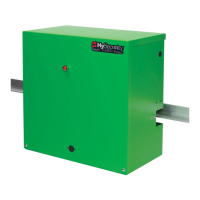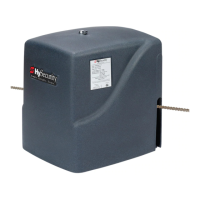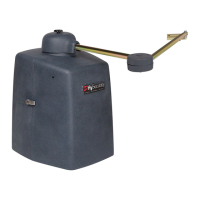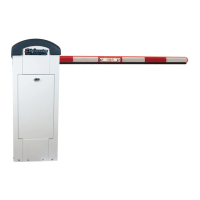www.hysecurity.com STC Inputs & Wiring D0559 Rev. A 61
Pressing the RESET button:
Clears any errors
Tunes the detectors on connected loops
Un-installs any detectors that have been removed
8. The Smart Touch Controller automatically governs frequency selection for all HY-5A detector modules.
This simplies installation and guarantees that there is no cross-talk between multiple loops. The
frequency and call level can also be manually selected; if this is required, refer to the appropriate loop
set ( ELD, ILD, OLD, RLD) in the Installer Menu: Table 2 on page 42.
9. Sensitivity is the only adjustment available on the detector itself. Generally, sensitivity does not need to be
increased unless the loop is large or there are multiple loops connected to one detector.
NOTE: Do not exceed more than 200 square feet (61 square meters) of loop area to one detector.
If required, adjust the sensitivity using the rotary dial.
The factory default setting is 1.
0 = Low with boost* 4 = Low without boost
1 = Normal with boost* 5 = Normal without boost
2 = Medium with boost* 6 = Medium without boost
3 = High with boost* 7 = High without boost
NOTE: *A boost feature is applied for settings 0 through 3. Boost increases the sensitivity
during a call and is useful for maintaining continuous detection if the signal becomes weak
(such as with tractor-trailer trucks). Sensitivity settings 4 through 7 are the same as 0
through 3, but without the boost feature.
pHoto eYes (non-ContaCt) InstallatIon
Plan to integrate photo eyes (photoelectric sensors) in your site plan. Photo eyes are wired to the STC and
require low voltage conduit to the operator and power supply. If your site conditions require a battery-powered
transmitter, it can be ordered through your distributor.
Understand your site requirements and use the layout diagrams available in the appendix to determine the most
appropriate mounting positions for any additional photo eyes. The Smart Touch Controller has two photoelectric
sensor inputs (Photo eye open and Photo eye close).
If there are no other secondary external entrapment protection sensors (typically an edge sensor), then for slide
gates, swing gates or any site that must comply with UL 325 regulations, at least two photo eyes are required to
serve and reverse the gate in each direction of travel.
The two common photoelectric sensor types are thru-beam and retro-reective; each has its advantages. A
thru-beam sensor is generally more powerful and able to function reliably with dirty optics and in poor weather.
1
2
3
4
5
6
7
0
Rotary dial
